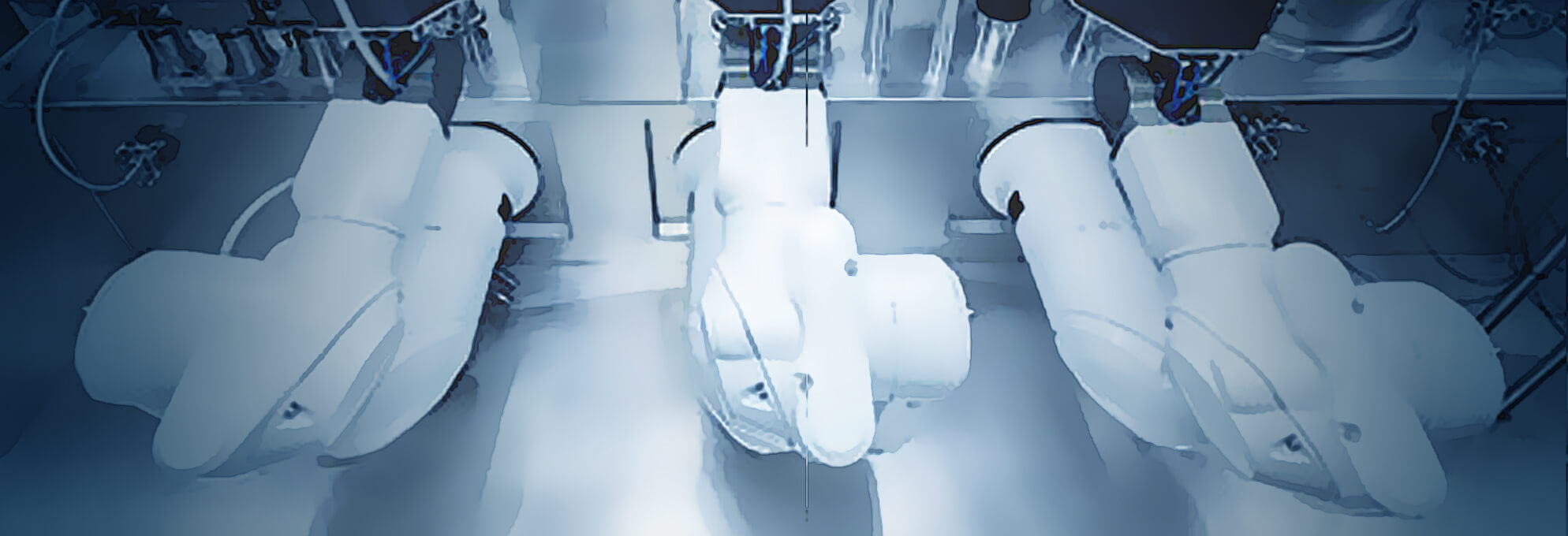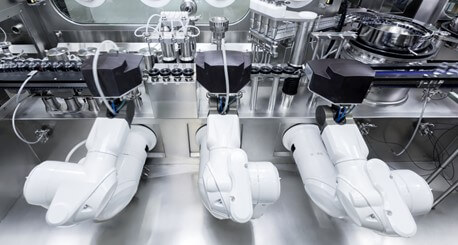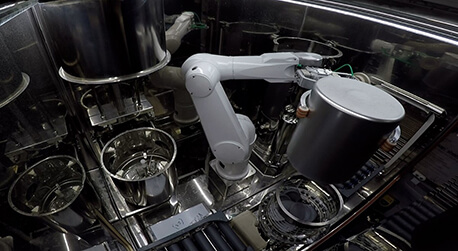Robotics and Automation in Pharmaceutical Production A paradigm shift led by EU GMP Annex 1

Pharmaceutical manufacturing is characterized by a very slow adoption of technological innovations because its strong regulation leads companies to invest mainly in more established technologies. This assists with ease of qualification and validation, along with technical difficulties in hardware management. However, the last few years have seen the trend of robotization increasingly emerge and consolidate in pharmaceutical workshops.
Robots first made their appearance in solutions provided by original equipment manufacturers, such as cartoning and filling machines, immediately capturing the interest of drug manufacturers. At a later stage, robots were protagonists in numerous analyses by the majority of end users for intralogistics and to upgrade efficiency in low-value-added auxiliary tasks along the machines (e.g., loading-unloading autoclaves, palletizing tubs). Today, the technology is mature enough to move toward mass adoption for drug manufacturing to such an extent that the degree of automation is expected to increase in the coming years at record rates.
 Figure 1 Robotic Filling Line — Courtesy of STERILINE
Figure 1 Robotic Filling Line — Courtesy of STERILINE
The revision of EU GMP Annex 1: Manufacture of Sterile Medicinal Products, published in August 2022 and effective starting August 2023, is set to further accelerate the rate of adoption of robotic solutions, leading to a technological and cultural shift. This very same regulation that may have slowed down the process in the past is now the biggest driver of innovation. It is impacting one of the most challenging and sensitive areas of production, such as aseptic manufacturing, which seeks to dramatically reduce manual operations and increase the separation between product and operator (which statistically represents the highest risk of batch contamination). In fact, in the revision of Annex 1, Section 2.1 states, “The use of appropriate technologies (e.g., Restricted Access Barriers Systems (RABS), isolators, robotic systems, rapid/alternative methods and continuous monitoring systems) should be considered to increase the protection of the product.”
The benefits of automation and robotics can be noticed in multiple production aspects related to health, safety and environment, and quality and production efficiency.
By having a robot performing a given operation, whether in an aseptic environment or not, one can assume that the robot is going to repetitively execute the given instructions exactly in every cycle. In a sense, we can say that the robot is the perfect solution for having the certainty of having a selected standard operating procedure respected in every step, with the possibility of fully automatic tracking of operations performed directly stored in the batch record.
The following are examples of how robotization effects our industry:
- Health, safety and environment — Concerning operator safety, the robot can reduce the impact of non-ergonomic or risky operations. Ergonomically, preventing the operator from performing repeated operations, such as lifting heavy steel trays containing products to be lyophilized that must be aseptically transferred to reduce particle release, can bring quite a few benefits in reducing the physical effort. Similarly, the safety related to the production of a cytotoxic drug under an isolator or C-RABS goes to be enhanced, as not only an operator is perfectly separated from the toxic product, but one can achieve the reduction of the risk of human error during handling through interface gloves with the environment inside the isolator.
- Quality — Since the greatest risk of contamination in the pharmaceutical environment is given by the presence of the operators (even with proper gowning protection), leaving the largest number of operations in charge to a robot instead of an operator leads the process to be safer. This would reduce the risk of contamination, thus increasing the quality of production. In addition, the same is true within barrier systems, where the risk of contamination is reduced, and it is also true for Grade A environments where there are no barrier systems, like a conventional clean room where the operator performs operations at a safe distance from the product being handled by robots.
In the case of a barrier system, such as RABS, where the internal environment is Grade A but the surrounding environment must be Grade B, a great advantage can be gained in loading and unloading equipment (e.g., freeze dryers, isolators) through robots due to the presence of the operator being moved away from the surrounding equipment, namely where the key access points for contaminants are placed. - Production Efficiency — With a focus on smart-data management and to increase the quality of the batch record, all operations performed by the robot can be recorded in every detail with the corresponding environmental parameters and robot status (an operation that, if carried out manually by an operator, would be extremely time-consuming and less robust). In addition, by increasing the number of sensors to equip robots and grippers, critical process parameters can be produced for more in-depth analysis (with machine learning and artificial intelligence tools). This would allow an early identification of drift trends and manufacturing nonconformities, with more tools for a proper root cause analysis. In this way, corrective action and preventive action can be promptly implemented, limiting the risk of losing control of production quality.
All this data regarding the robot's trajectories and movements in space, the complete traceability along the process (e.g., by implementing a vision sensor on the robot capable of reading barcodes or QR codes), can be automatically registered in the batch record.
To date, there are robots that can operate with up to Grade A characteristics, with ISO 5 performance and the possibility of easy validation from a microbiological compatibility and cleaning and decontamination media point of view. With a working radius of up to 3000 mm and payloads of hundreds of kilos, such robots can find many applications in all steps of production, from the active pharmaceutical ingredient tank handling (e.g., in Figure 2) and robotic vials filling lines (e.g., Figure 1) to secondary packaging and machine-tending operations. In addition, manufacturers increasingly are striving to provide solutions to match not only the technical process requirements, but also the documentation requirements to provide original equipment manufacturers and end users with strong rationales to implement the contamination control strategy required by Annex 1.
 Figure 2 Tank of API Handling — Courtesy of COMECER
Figure 2 Tank of API Handling — Courtesy of COMECER
At the pharmaceutical level, the robotics revolution is just beginning. Currently, robotics is already widely used in the secondary packaging stage, but the coming years will see massive adoption in aseptic manufacturing environments as well. This implies a deep paradigm shift, in which robot manufacturers will have to adapt to the unique requirements of the pharmaceutical sector (both at the level of robotic solution and supporting testing and documentation), and the pharmaceutical sector itself will be involved in automation and robotics related decision-making to embrace and to thrive with the full potential of pharma 4.0.



 Andrea Tanzini holds an MSc degree in automation engineering from Milan Polytechnic University and a second-level master’s degree in GMP compliance & validation at the University of Pavia, Italy. He is an active member of several PDA and International Society for Pharmaceutical Engineering (ISPE) study groups, both locally and globally. Andrea holds the position of Local Head of Business for pharma and medical devices at Staubli Robotics in Italy, where he is dedicated to the Italian pharmaceutical market development by collaborating with system integrators, OEMs, and engineering companies and assisting end users to minimize the risk of contamination, while also increasing the efficiency of production in every step of drug manufacturing by leveraging high value-added robotic solutions.
Andrea Tanzini holds an MSc degree in automation engineering from Milan Polytechnic University and a second-level master’s degree in GMP compliance & validation at the University of Pavia, Italy. He is an active member of several PDA and International Society for Pharmaceutical Engineering (ISPE) study groups, both locally and globally. Andrea holds the position of Local Head of Business for pharma and medical devices at Staubli Robotics in Italy, where he is dedicated to the Italian pharmaceutical market development by collaborating with system integrators, OEMs, and engineering companies and assisting end users to minimize the risk of contamination, while also increasing the efficiency of production in every step of drug manufacturing by leveraging high value-added robotic solutions.